Age and Living Situation as Key Factors in Understanding Changes in Alcohol Use during COVID-19 Confinement
Abstract
:1. Introduction
2. Materials and Methods
2.1. Design
2.2. Population
2.3. Procedure
2.4. Study Variables
2.5. Statistical Analysis
2.6. Ethical Aspects
3. Results
4. Discussion
5. Conclusions
- (a)
- Strategies to regulate alcohol consumption and restrict access to alcohol in contexts associated with young people’s leisure activities would be effective [11], especially in adults from 18 to 34 years old. In addition, considering that the rate of risky consumers in the youngest age range is around 32%, which is nine percentage points higher than what was found for other age groups, prevention, early detection, and treatment interventions should be promoted in this population group, especially for females.
- (b)
- In the older alcohol-drinking population, the consumption pattern did not vary substantially, which, in line with the existing literature, suggests that the main context for drinking is the home. Therefore, it would be advisable to carry out awareness campaigns about the effects and risks of alcohol consumption at home, focusing especially on the target population aged 45 to 64.
- (c)
- Among at-risk consumers from 35 to 64 years old, 60–70% live with a partner. Cohabitation and living alone are the situations that have shown the greatest increases in alcohol consumption during confinement. Therefore, awareness campaigns should be carried out related to alcohol consumption in couples within the home, intensifying in situations of crisis or periods similar to the COVID-19 pandemic.
- (d)
- Living in the family setting is a protective factor for high-risk consumers, given that there was a significant decrease in all the consumption indicators. This fact demonstrates the importance of the role of the family as a direct or indirect agent for prevention and in treatment processes.
Author Contributions
Funding
Institutional Review Board Statement
Informed Consent Statement
Conflicts of Interest
References
- Wang, C.; Pan, R.; Wan, X.; Tan, Y.; Xu, L.; Ho, C.S.; Ho, R.C. Immediate psychological responses and associated factors during the initial stage of the 2019 Coronavirus disease (COVID-19) epidemic among the general population in China. Int. J. Environ. Res. Public Health 2020, 17, 1729. [Google Scholar] [CrossRef] [Green Version]
- EMCDDA. EMCDDA Trendspotter Briefing: Impact of COVID-19 on Patterns of Drug Use and Drug-Related Harms in Europe; European Monitoring Centre for Drugs and Drug Addiction: Lisbon, Portugal, 2020. [Google Scholar]
- Sixto-Costoya, A.; Lucas-Domínguez, R.; Agulló-Calatayud, V. COVID-19 y su repercusión en las adicciones. Health Addict. 2021, 21, 259–278. [Google Scholar] [CrossRef]
- Vanderbruggen, N.; Matthys, F.; Van Laere, S.; Zeeuws, D.; Santermans, L.; Ameele, S.V.D.; Crunelle, C.L. Self-reported alcohol, tobacco, and cannabis use during COVID-19 lockdown measures: Results from a web-based survey. Eur. Addict. Res. 2020, 26, 309–315. [Google Scholar] [CrossRef]
- World Health Organization. Plan de Acción para Reducir el Consumo Nocivo de Alcohol 2012–2020; WHO: Geneva, Switzerland, 2020; Available online: http://copolad.eu/es/publicacion/32#:~:text=El%20Plan%20de%20Ac-ci%C3%B3n%20europeo,nocivas%20del%20uso%20de%20alcohol (accessed on 1 August 2021).
- Rehm, J.; Kilian, C.; Ferreira-Borges, C.; Jernigan, D.; Monteiro, M.; Parry, C.D.; Sanchez, Z.M.; Manthey, J. Alcohol use in times of the COVID 19: Implications for monitoring and policy. Drug Alcohol Rev. 2020, 39, 301–304. [Google Scholar] [CrossRef] [PubMed]
- Carbia, C.; Lannoy, S.; Maurage, P.; López-Caneda, E.; O’Riordan, K.J.; Dinan, T.G.; Cryan, J.F. A biological framework for emotional dysregulation in alcohol misuse: From gut to brain. Mol. Psychiatry 2021, 26, 1098–1118. [Google Scholar] [CrossRef] [PubMed]
- Testino, G. Are patients with alcohol use disorders at increased risk for COVID-19 infection? Alcohol Alcohol. 2020, 55, 344–346. [Google Scholar] [CrossRef]
- Kilian, C.; Rehm, J.; Allebeck, P.; Braddick, F.; Gual, A.; Barták, M.; Bloomfield, K.; Gil, A.; Neufeld, M.; O’Donnell, A.; et al. Alcohol consumption during the COVID-19 pandemic in Europe: A large-scale cross-sectional study in 21 countries. Addiction 2021, 1–12. [Google Scholar] [CrossRef]
- Callinan, S.; MacLean, S. COVID-19 makes a stronger research focus on home drinking more important than ever. Drug Alcohol Rev. 2020, 39, 613–615. [Google Scholar] [CrossRef]
- Villanueva, V.J.; Motos, P.; Isorna, M.; Villanueva, V.; Blay, P.; Vázquez-Martínez, A. Impacto de las medidas de confinamiento durante la pandemia de COVID-19 en el consumo de riesgo de alcohol. Rev. Española De Salud Pública 2021, 95, e1–e13. [Google Scholar]
- Bade, R.; Simpson, B.S.; Ghetia, M.; Nguyen, L.; White, J.M.; Gerber, C. Changes in alcohol consumption associated with social distancing and self-isolation policies triggered by COVID-19 in South Australia: A wastewater analysis study. Addiction 2021, 116, 1600–1605. [Google Scholar] [CrossRef] [PubMed]
- European Monitoring Centre for Drugs and Drug Addiction. Impact of COVID-19 on Drug Markets, Use, Harms and Drug Services in the Community and Prisons: Results from an EMCDDA Trendspotter Study; Publications Office of the European Union: Luxembourg, 2021. [Google Scholar]
- Sun, Y.; Li, Y.; Bao, Y.; Meng, S.; Sun, Y.; Schumann, G.; Kosten, T.; Strang, J.; Lu, L.; Shi, J. Brief report: Increased addictive internet and substance use behavior during the COVID-19 pandemic in China. Am. J. Addict. 2020, 29, 268–270. [Google Scholar] [CrossRef]
- Bonar, E.E.; Parks, M.J.; Gunlicks-Stoessel, M.; Lyden, G.R.; Mehus, C.J.; Morrell, N.; Patrick, M.E. Binge drinking before and after a COVID-19 campus closure among first-year college students. Addict. Behav. 2021, 118, 106879. [Google Scholar] [CrossRef] [PubMed]
- Jackson, S.E.; Garnett, C.; Shahab, L.; Oldham, M.; Brown, J. Association of the COVID-19 lockdown with smoking, drinking and attempts to quit in England: An analysis of 2019–20 data. Addiction 2021, 116, 1233–1244. [Google Scholar] [CrossRef] [PubMed]
- White, H.R.; Stevens, A.K.; Hayes, K.; Jackson, K.M. Changes in alcohol consumption among college students due to COVID-19: Effects of campus closure and residential change. J. Stud. Alcohol Drugs 2020, 81, 725–730. [Google Scholar] [CrossRef] [PubMed]
- Gritsenko, V.; Skugarevsky, O.; Konstantinov, V.; Khamenka, N.; Marinova, T.; Reznik, A.; Isralowitz, R. COVID 19 Fear, stress, anxiety, and substance use among Russian and Belarusian university students. Int. J. Ment. Health Addict. 2020, 1–7. [Google Scholar] [CrossRef]
- Czeisler, M.É.; Lane, R.I.; Petrosky, E.; Wiley, J.F.; Christensen, A.; Njai, R.; Weaver, M.D.; Robbins, R.; Facer-Childs, E.R.; Barger, L.K.; et al. Mental health, substance use, and suicidal ideation during the COVID-19 pandemic—United States, 24–30 June 2020. MMWR Morb. Mortal. Wkly. Rep. 2020, 69, 1049–1057. [Google Scholar] [CrossRef] [PubMed]
- Lechner, W.V.; Laurene, K.R.; Patel, S.; Anderson, M.; Grega, C.; Kenne, D.R. Changes in alcohol use as a function of psychological distress and social support following COVID-19 related university closings. Addict. Behav. 2020, 110, 106527. [Google Scholar] [CrossRef]
- Neill, E.; Meyer, D.; Toh, W.L.; Van Rheenen, T.E.; Phillipou, A.; Tan, E.J.; Rossell, S.L. Alcohol use in Australia during the early days of the COVID-19 pandemic: Initial results from the COLLATE project. Psychiatry Clin. Neurosci. 2020, 74, 542–549. [Google Scholar] [CrossRef]
- Villanueva-Blasco, V.J.; Villanueva Silvestre, V.; Isorna, M.; Motos, P.; Blay, P.; Vázquez-Martínez, A. Changes in alcohol consumption pattern based on gender during COVID-19 confinement in Spain. Int. J. Environ. Res. Public Health 2021, 18, 8028. [Google Scholar] [CrossRef]
- Jacob, L.; Smith, L.; Armstrong, N.C.; Yakkundi, A.; Barnett, Y.; Butler, L.; Meyer, J. Alcohol use and mental health during COVID-19 lockdown: A cross-sectional study in a sample of UK adults. Drug Alcohol Depend. 2021, 219, 108488. [Google Scholar] [CrossRef] [PubMed]
- Rossow, I.; Bye, E.; Moan, I.; Kilian, C.; Bramness, J. Changes in alcohol consumption during the COVID-19 pandemic—Small change in total consumption, but increase in proportion of heavy drinkers. Int. J. Environ. Res. Public Health 2021, 18, 4231. [Google Scholar] [CrossRef] [PubMed]
- Koopmann, A.; Georgiadou, E.; Kiefer, F.; Hillemacher, T. Did the general population in Germany drink more alcohol during the COVID-19 pandemic lockdown? Alcohol Alcohol. 2020, 55, 698–699. [Google Scholar] [CrossRef]
- Pollard, M.S.; Tucker, J.S.; Green, H.D. Changes in adult alcohol use and consequences during the COVID-19 pandemic in the US. JAMA Netw. Open 2020, 3, e2022942. [Google Scholar] [CrossRef] [PubMed]
- Rodriguez, L.M.; Litt, D.M.; Stewart, S.H. Drinking to cope with the pandemic: The unique associations of COVID-19-related perceived threat and psychological distress to drinking behaviors in American men and women. Addict. Behav. 2020, 110, 106532. [Google Scholar] [CrossRef]
- Callinan, S.; Smit, K.; Mojica-Perez, Y.; D’Aquino, S.; Moore, D.; Kuntsche, E. Shifts in alcohol consumption during the COVID-19 pandemic: Early indications from Australia. Addiction 2021, 116, 1381–1388. [Google Scholar] [CrossRef]
- Ally, K.; Lovatt, M.; Meier, P.; Brennan, A.; Holmes, J. Developing a social practice-based typology of British drinking culture in 2009-2011: Implications for alcohol policy analysis. Addiction 2016, 111, 1568–1579. [Google Scholar] [CrossRef] [PubMed]
- Canfield, M.; Chandler, V.; Foster, J.H. Home drinking in women over 30 years of age. Findings from an internet survey in England. J. Subst. Use 2021, 26, 376–382. [Google Scholar] [CrossRef]
- Foster, J.; Canfield, M. Predictors of hazardous drinking among home drinkers. J. Subst. Use 2017, 22, 637–642. [Google Scholar] [CrossRef]
- Cluver, L.; Lachman, J.M.; Sherr, L.; Wessels, I.; Krug, E.; Rakotomalala, S.; Blight, S.; Hillis, S.; Bachman, G.; Green, O.; et al. Parenting in a time of COVID-19. Lancet 2020, 395, e64. [Google Scholar] [CrossRef]
- Schmits, E.; Glowacz, F. Changes in alcohol use during the COVID-19 Pandemic: Impact of the lockdown conditions and mental health factors. Int. J. Ment. Health Addict. 2021, 1–12. [Google Scholar] [CrossRef]
- Clay, J.M.; Parker, M.O. Alcohol use and misuse during the COVID-19 pandemic: A potential public health crisis? Lancet Public Health 2020, 5, e259. [Google Scholar] [CrossRef]
- Instituto Nacional de Estadística. Encuesta sobre Equipamiento y Uso de Tecnologías de Información y Comunicación en los Hogares; INE: Madrid, Spain, 2019. [Google Scholar]
- Spanish Government. Ley de 5 de Diciembre, de Protección de Datos Personales y Garantía de los Derechos Digitales; Agencia Estatal Boletín Oficial del Estado: Madrid, Spain, 2018. [Google Scholar]
- Observatorio Español de las Drogas y las Adicciones. EDADES Informe 2019. Alcohol, Tabaco y otras Drogas Ilegales en España. España: Plan Nacional Sobre Drogas; Ministerio de Sanidad, Consumo y Bienestar Social: Madrid, Spain, 2020. Available online: http://www.pnsd.mscbs.gob.es/profesionales/sistemasInformacion/sistemaInformacion/pdf/2019_Informe_EDADES.pdf (accessed on 9 July 2021).
- Contel, M.; Gual, A.; Colom, J. Alcohol use disorders identification test (Audit): Translation and validation to Catalan and Spanish. Adicciones 1999, 11, 337–347. [Google Scholar]
- World Health Organization. Glosario de Términos de Alcohol y Drogas; WHO: Geneva, Switzerland, 1994; Available online: https://apps.who.int/iris/handle/10665/44000 (accessed on 2 September 2021).
- Garcia Carretero, M.A.; Novalbos Ruiz, J.P.; Martinez Delgado, J.M.; O’Ferrall Gonzalez, C. Validation of the alcohol use disorders identification test in university students: AUDIT and AUDIT-C. Adicciones 2016, 28, 194–204. [Google Scholar] [CrossRef] [PubMed] [Green Version]
- Rodríguez-Martos, A.; Santamariña, E. Does the short form of the alcohol use disorders identification test (AUDIT-C) work at a trauma emergency department? Subst. Use Misuse 2007, 42, 923–932. [Google Scholar] [CrossRef]
- Avery, A.R.; Tsang, S.; Seto, E.Y.W.; Duncan, G.E. Stress, anxiety, and change in alcohol use during the COVID-19 pandemic: Findings among adult twin pairs. Front. Psychiatry 2020, 11, 1030. [Google Scholar] [CrossRef]
- Bollen, Z.; Pabst, A.; Creupelandt, C.; Fontesse, S.; Lannoy, S.; Pinon, N.; Maurage, P. Prior drinking motives predict alcohol consumption during the COVID-19 lockdown: A cross-sectional online survey among Belgian college students. Addict. Behav. 2021, 115, 106772. [Google Scholar] [CrossRef]
- Chodkiewicz, J.; Talarowska, M.; Miniszewska, J.; Nawrocka, N.; Bilinski, P. Alcohol consumption reported during the COVID-19 pandemic: The initial stage. Int. J. Environ. Res. Public Health 2020, 17, 4677. [Google Scholar] [CrossRef]
- Callinan, S.; Livingston, M.; Room, R.; Dietze, P. Drinking contexts and alcohol consumption: How much alcohol is consumed in different Australian locations? J. Stud. Alcohol Drugs 2016, 77, 612–619. [Google Scholar] [CrossRef]
- Gough, B.; Madden, M.; Morris, S.; Atkin, K.; McCambridge, J. How do older people normalise their drinking?: An analysis of interviewee accounts. Appetite 2020, 146, 104513. [Google Scholar] [CrossRef]
- Wardell, J.D.; Kempe, T.; Rapinda, K.K.; Single, A.; Bilevicius, E.; Frohlich, J.R.; Hendershot, C.S.; Keough, M.T. Drinking to cope during COVID-19 pandemic: The Role of external and internal factors in coping motive pathways to alcohol use, solitary drinking, and alcohol problems. Alcohol. Clin. Exp. Res. 2020, 44, 2073–2083. [Google Scholar] [CrossRef]
- De Goeij, M.C.; Suhrcke, M.; Toffolutti, V.; Van de Mheen, D.; Schoenmakers, T.M.; Kunst, A.E. How economic crises affect alcohol consumption and alcohol-related health problems: A realist systematic review. Soc. Sci. Med. 2015, 131, 131–146. [Google Scholar] [CrossRef] [PubMed] [Green Version]
- Colell, E.; Sánchez-Niubò, A.; Domingo-Salvany, A. Sex differences in the cumulative incidence of substance use by birth cohort. Int. J. Drug Policy 2013, 24, 319–325. [Google Scholar] [CrossRef] [PubMed] [Green Version]
- Keyes, K.M.; Grant, B.F.; Hasin, D.S. Evidence for a closing gender gap in alcohol use, abuse, and dependence in the United States population. Drug Alcohol Depend. 2008, 93, 21–29. [Google Scholar] [CrossRef] [Green Version]
- Roche, A.; Deehan, A. Women’s alcohol consumption: Emerging patterns, problems and public health implications. Drug Alcohol Rev. 2002, 21, 169–178. [Google Scholar] [CrossRef]
- Slade, T.; Chapman, C.; Swift, W.; Keyes, K.; Tonks, Z.; Teesson, M.R. Birth cohort trends in the global epidemiology of alcohol use and alcohol-related harms in men and women: Systematic review and metaregression. BMJ Open 2016, 6, e011827. [Google Scholar] [CrossRef] [PubMed]
- Cheng, H.G.; Anthon, J.C. A new era for drinking? Epidemiological evidence on adolescent male–female differences in drinking incidence in the United States and Europe. Soc. Psychiatry Psychiatr. Epidemiol. 2017, 52, 117–126. [Google Scholar] [CrossRef] [Green Version]
- Degenhardt, L.; O’Loughlin, C.; Swift, W.; Romaniuk, H.; Carlin, J.; Coffey, C.; Hall, W.; Patton, G. The persistence of adolescent binge drinking into adulthood: Findings from a 15-year prospective cohort study. BMJ Open 2013, 3, e003015. [Google Scholar] [CrossRef] [PubMed] [Green Version]
- Davis, C.G.; Thake, J.; Vilhena, N. Social desirability biases in self-reported alcohol consumption and harms. Addict. Behav. 2010, 35, 302–311. [Google Scholar] [CrossRef]
- Dryhurst, S.; Schneider, C.R.; Kerr, J.; Freeman, A.L.J.; Recchia, G.; Van der Bles, A.M.; Spiegelhalter, D.; Van der Linden, S. Risk perceptions of COVID-19 around the world. J. Risk Res. 2020, 23, 994–1006. [Google Scholar] [CrossRef]
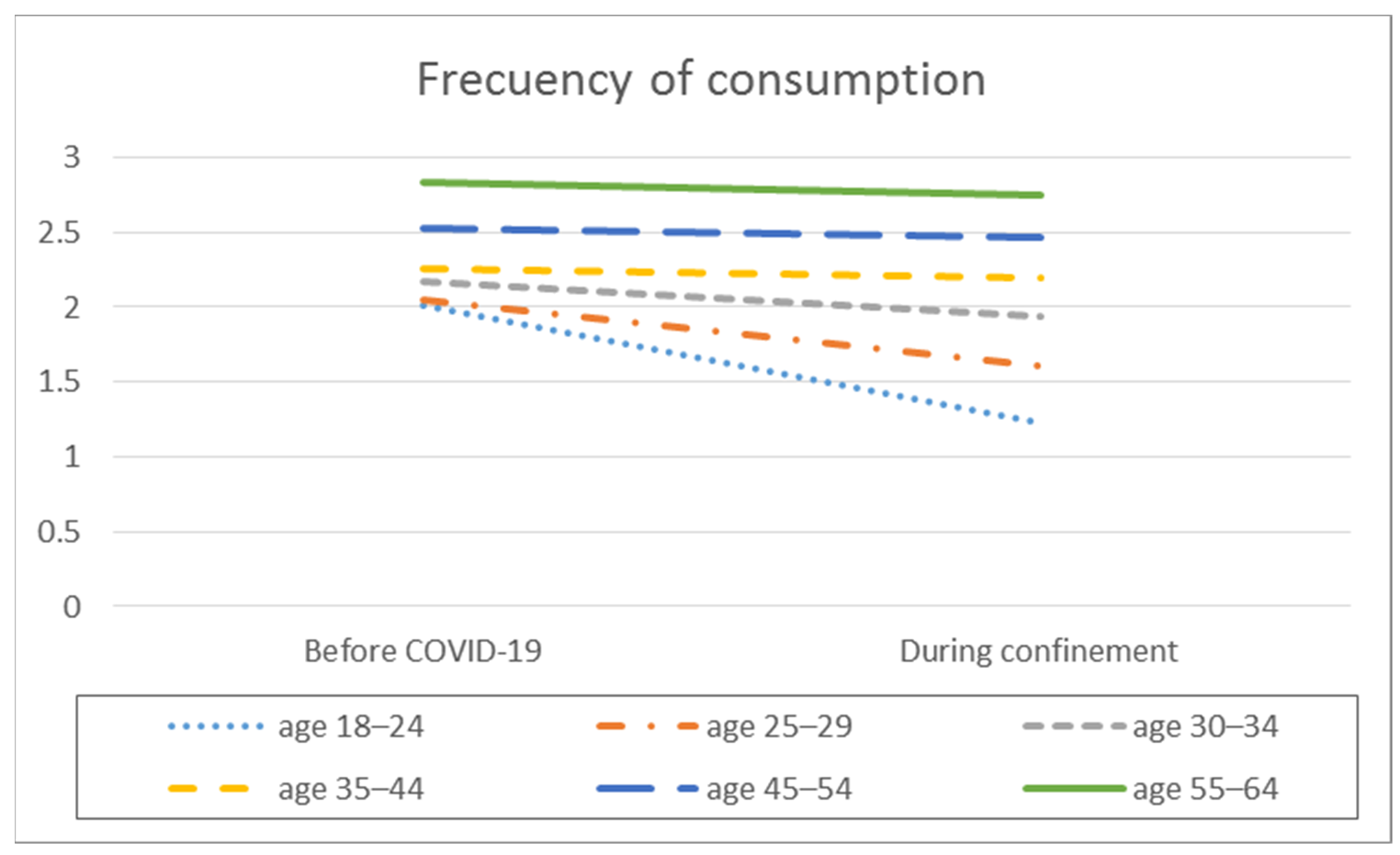
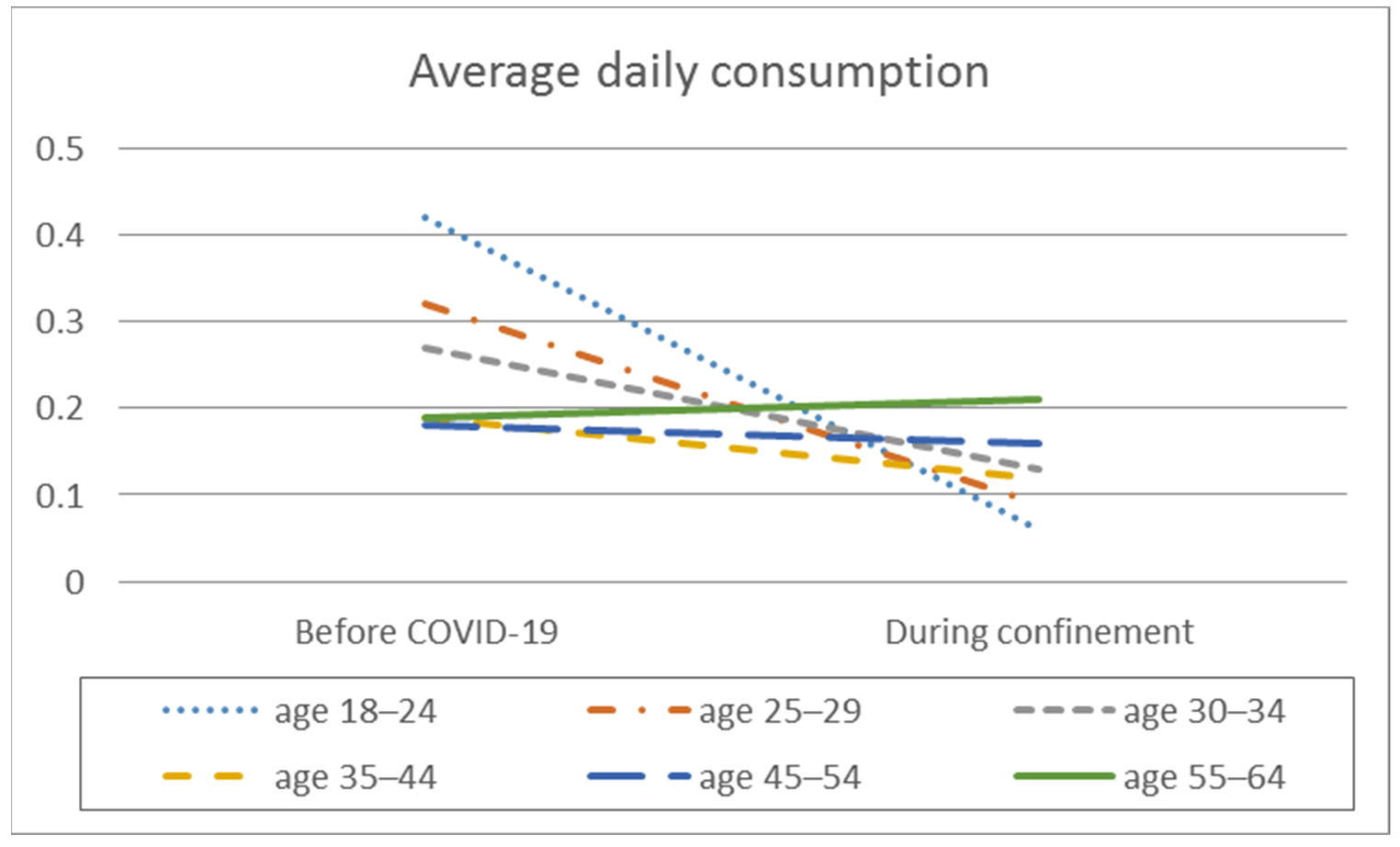
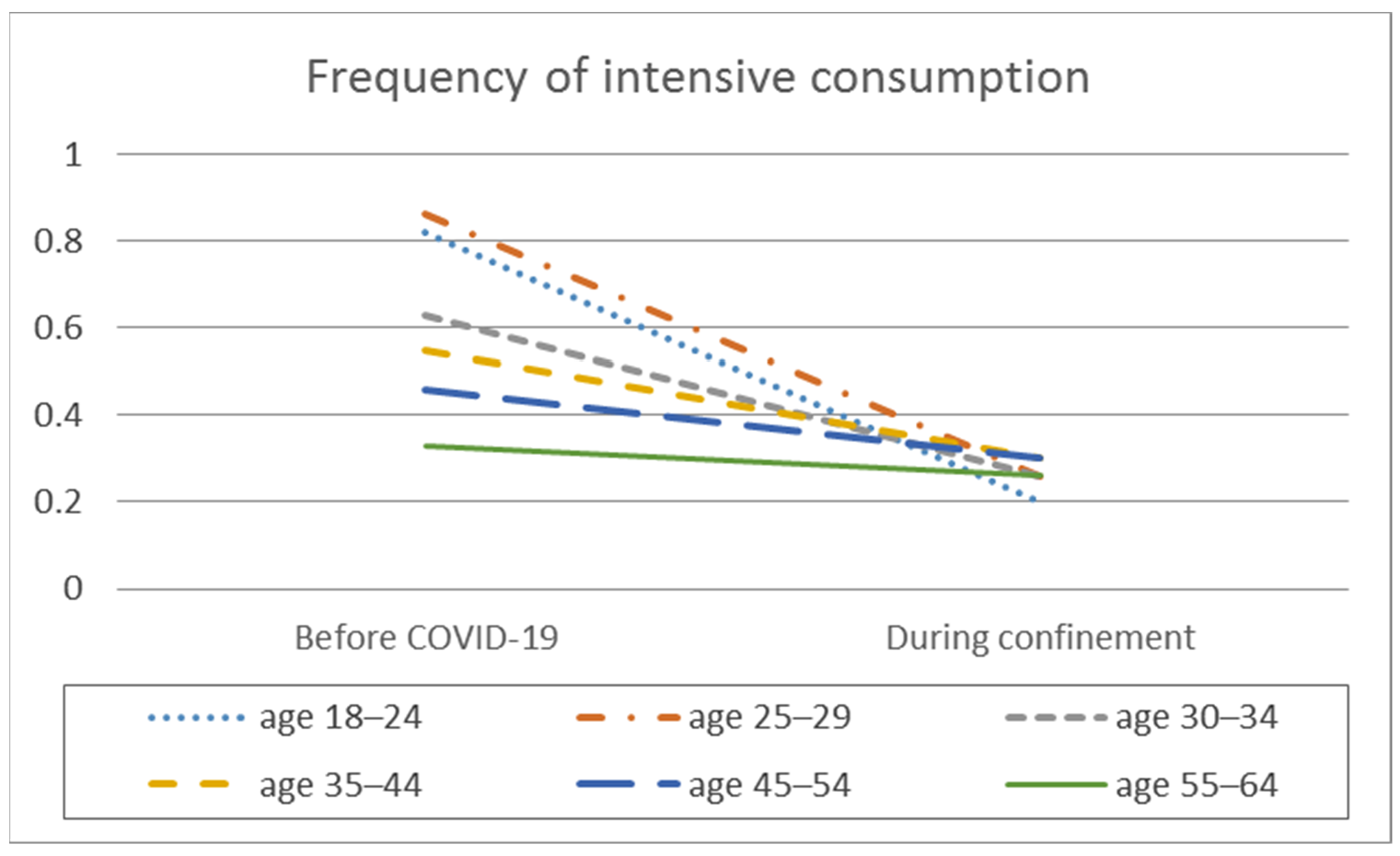
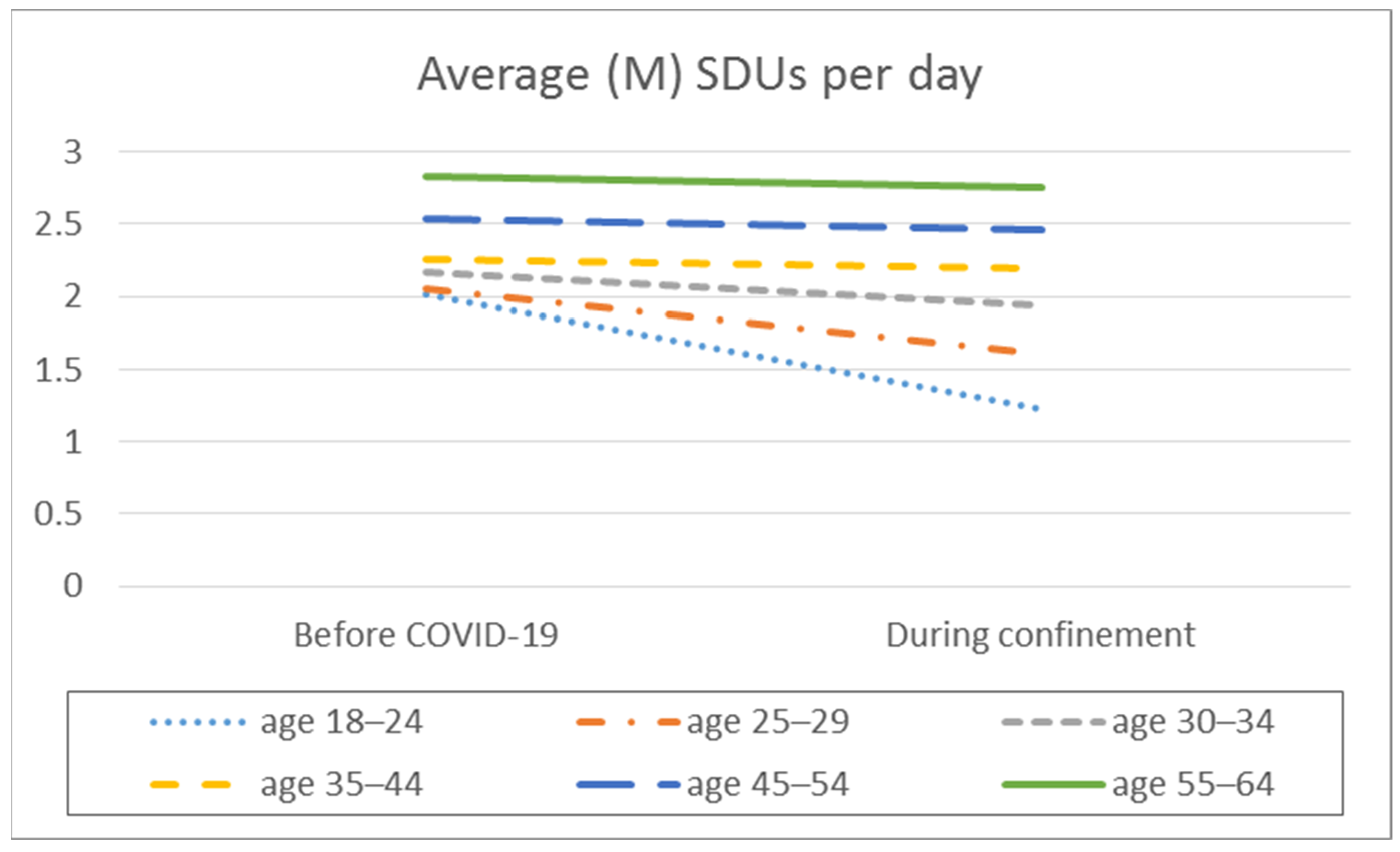

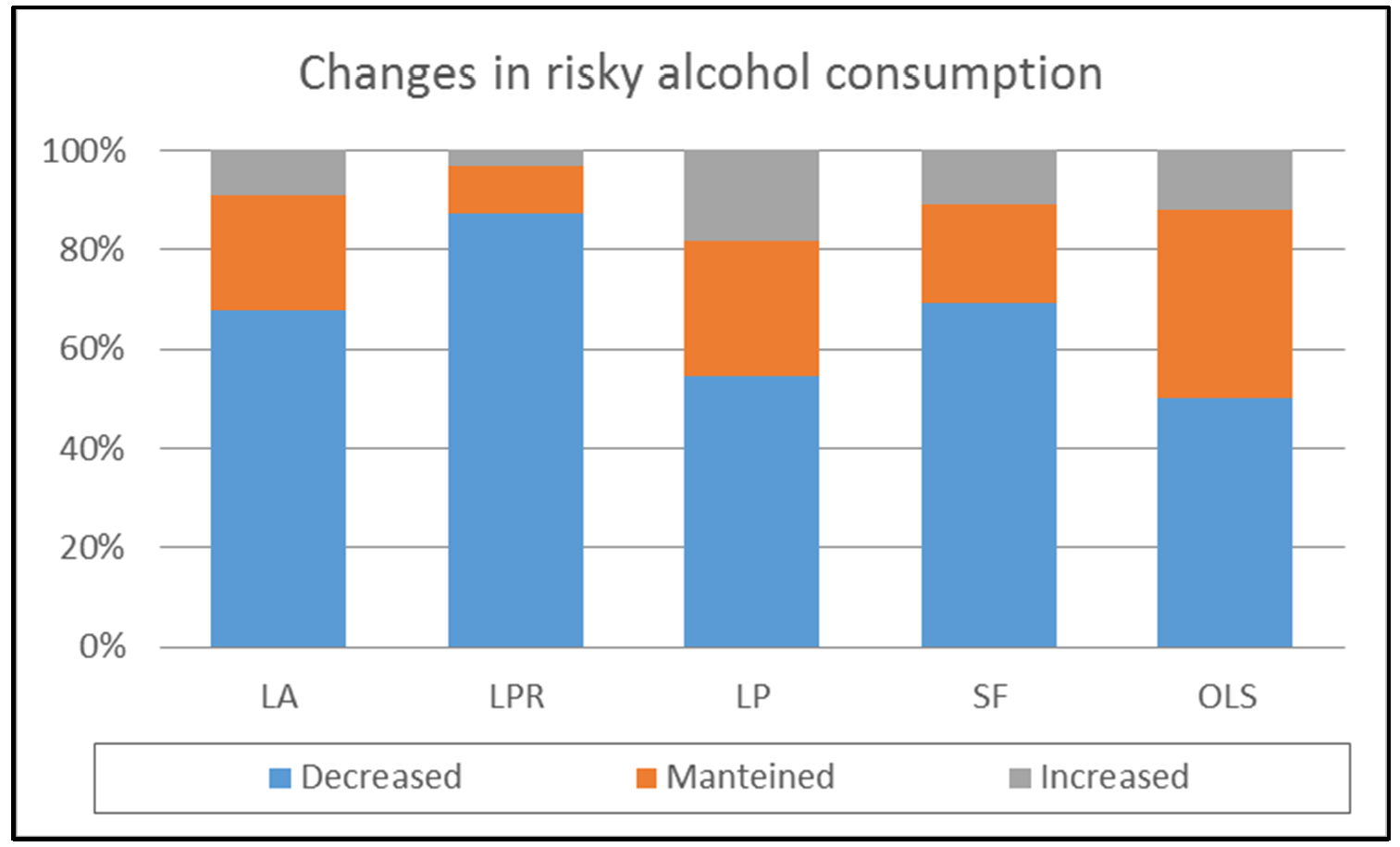
| Age | ||||||||
|---|---|---|---|---|---|---|---|---|
| Total % (n) | 18–24 % (n) | 25–29 % (n) | 30–34 % (n) | 35–44 % (n) | 45–54 % (n) | 55–64 % (n) | ||
| AUDIT-C | Decreased | 49.5 (1101) | 73 (301) | 62.6 (309) | 47.6 (154) | 34.7 (172) | 31.8 (120) | 24.7 (45) |
| Maintained | 33.8 (810) | 17.7 (73) | 26.8 (132) | 36.8 (119) | 42.1 (208) | 46.8 (177) | 55.5 (101) | |
| Increased | 16.7 (371) | 9.2 (38) | 10.5 (52) | 15.4 (50) | 23 (114) | 21.5 (81) | 19.6 (36) | |
| Frequency of consumption | Decreased | 36.2 (827) | 59.5 (245) | 45 (222) | 34.1 (110) | 24.1 (119) | 24.9 (94) | 20.3 (37) |
| Maintained | 45.4 (1037) | 29.4 (121) | 41 (202) | 45.5 (147) | 50.6 (250) | 54.8 (207) | 60.4 (110) | |
| Increased | 18.3 (418) | 11.1 (46) | 14 (69) | 20.4 (66) | 25.3 (125) | 20.4 (77) | 19.2 (35) | |
| Average daily consumption | Decreased | 14.2 (323) | 26.9 (111) | 21 (104) | 11.4 (37) | 8.5 (42) | 5.8 (22) | 3.8 (7) |
| Maintained | 82.8 (1890) | 71.6 (295) | 75.7 (373) | 85.8 (277) | 88.7 (438) | 89.4 (338) | 92.9 (169) | |
| Increased | 3 (69) | 1.4 (6) | 3.2 (16) | 2.8 (9) | 2.8 (14) | 4.7 (18) | 3.2 (6) | |
| Frequency of intensive consumption | Decreased | 29.3 (668) | 46.6 (192) | 39.8 (196) | 29.5 (95) | 22.2 (110) | 16.2 (61) | 7.6 (14) |
| Maintained | 66.4 (1515) | 49.5 (204) | 57.6 (284) | 65 (210) | 72.9 (360) | 78.8 (298) | 87.4 (159) | |
| Increased | 4.3 (99) | 3.9 (16) | 2.6 (13) | 5.6 (18) | 4.8 (24) | 5.1 (19) | 4.9 (9) | |
| Average SDUs 1 per day | Decreased | 7.5 (171) | 17.5 (72) | 8.5 (42) | 4.6 (15) | 3.8 (19) | 4.5 (17) | 3.3 (6) |
| Maintained | 88.6 (2021) | 80.3 (331) | 88.6 (437) | 92 (297) | 91.1 (450) | 89.4 (338) | 92.3 (168) | |
| Increased | 3.9 (90) | 2.2 (9) | 2.8 (14) | 3.4 (11) | 5.1 (25) | 6.1 (23) | 4.3 (8) | |
| Before Confinement M (SD 1) | During Confinement M (SD 1) | t | p | d | ||
|---|---|---|---|---|---|---|
| Frequency of consumption | 18–24 | 2.01 (0.846) | 1.22 (1.245) | 13.864 | 0.001 | −0.722 |
| 25–29 | 2.05 (0.860) | 1.61 (1.228) | 8.685 | 0.001 | −0.378 | |
| 30–34 | 2.17 (0.871) | 1.94 (1.280) | 4.484 | 0.001 | −0.198 | |
| 35–44 | 2.25 (0.997) | 2.19 (1.313) | 1.375 | 0.170 | ||
| 45–54 | 2.53 (1.009) | 2.46 (1.266) | 1.480 | 0.140 | ||
| 55–64 | 2.83 (1.049) | 2.75 (1.273) | 0.241 | 0.241 | ||
| Average daily consumption | 18–24 | 0.42 (0.733) | 0.06 (0.278) | 10.043 | 0.001 | −0.619 |
| 25–29 | 0.32 (0.630) | 0.09 (0.331) | 8.140 | 0.001 | −0.440 | |
| 30–34 | 0.27 (0.635) | 0.13 (0.372) | 4.465 | 0.001 | −0.268 | |
| 35–44 | 0.19 (0.504) | 0.12 (0.440) | 3.375 | 0.001 | −0.139 | |
| 45–54 | 0.18 (0.454) | 0.16 (0.437) | 0.810 | 0.418 | ||
| 55–64 | 0.19 (0.427) | 0.21 (0.571) | −0.873 | 0.384 | ||
| Frequency of intensive consumption | 18–24 | 0.82 (0.889) | 0.20 (0.603) | 13.574 | 0.001 | −0.591 |
| 25–29 | 0.86 (0.965) | 0.26 (0.645) | 14.170 | 0.001 | −0.588 | |
| 30–34 | 0.63 (0.846) | 0.26 (0.664) | 8.512 | 0.001 | −0.416 | |
| 35–44 | 0.55 (0.859) | 0.30 (0.815) | 7.846 | 0.001 | −0.332 | |
| 45–54 | 0.46 (0.813) | 0.30 (0.725) | 4.206 | 0.001 | −0.207 | |
| 55–64 | 0.33 (0.778) | 0.26 (0.774) | 1.658 | 0.099 | ||
| Average SDUs 2 per day | 18–24 | 0.30 (0.688) | 0.08 (0.405) | 5.953 | 0.001 | −0.246 |
| 25–29 | 0.16 (0.512) | 0.08 (0.381) | 3.527 | 0.001 | −0.148 | |
| 30–34 | 0.14 (0.498) | 0.12 (0.467) | 1.056 | 0.292 | ||
| 35–44 | 0.11 (0.407) | 0.13 (0.482) | −1.368 | 0.172 | ||
| 45–54 | 0.15 (0.413) | 0.16 (0.454) | −0.683 | 0.495 | ||
| 55–64 | 0.17 (0.454) | 0.21 (0.523) | −1.630 | 0.105 |
| Age | n | Before Confinement % (n) | During Confinement % (n) | X2MN 1 | p | Phi |
|---|---|---|---|---|---|---|
| 18–24 | 400 | 32 (128) | 7.8 (31) | 86.523 | 0.001 | 0.282 |
| 25–29 | 454 | 31.3 (142) | 12.6 (57) | 62.151 | 0.001 | 0.318 |
| 30–34 | 338 | 22.8 (77) | 12.5 (43) | 21.121 | 0.001 | 0.449 |
| 35–44 | 531 | 22.5 (119) | 18.3 (97) | 6.782 | 0.017 | 0.556 |
| 45–54 | 402 | 22.7 (91) | 19.9 (80) | 2.485 | 0.182 | |
| 55–64 | 220 | 22.7 (50) | 20.9 (46) | 0.666 | 0.541 |
| Alcohol Variables | Decreased % (n) | Maintained % (n) | Increased % (n) |
|---|---|---|---|
| AUDIT-C | 67.4 (409) | 21.6 (131) | 11 (67) |
| Frequency of consumption | 39 (237) | 46 (279) | 15.1 (91) |
| Average daily consumption | 34.7 (210) | 59 (358) | 6.4 (39) |
| Frequency of intensive consumption | 65.7 (398) | 28.5 (173) | 5.8 (35) |
| Average SDUs 1 per day | 14 (84) | 76.5 (465) | 9.5 (58) |
| Living Situation | ||||||
|---|---|---|---|---|---|---|
| LA % (n) | LPR % (n) | LP % (n) | FS % (n) | OLS % (n) | ||
| AUDIT-C | Decreased | 66.6 (48) | 87.4 (176) | 54.4 (131) | 63.9 (23) | 50 (28) |
| Maintained | 23,6 (17) | 9.7 (20) | 27.4 (66) | 19.4 (7) | 39.3 (22) | |
| Increased | 9.7 (7) | 3 (6) | 18.2 (44) | 16.6 (6) | 10.7 (6) | |
| Frequency of consumption | Decreased | 45.8 (33) | 59.9 (121) | 21.2 (51) | 44.1 (16) | 26.8 (15) |
| Maintained | 43.1 (31) | 32.2 (65) | 53.9 (130) | 50 (18) | 62.5 (35) | |
| Increased | 11.1 (8) | 7.9 (16) | 24.9 (60) | 6 (2) | 10.1 (6) | |
| Average daily consumption | Decreased | 41.6 (30) | 51 (103) | 21.2 (51) | 22.2 (8) | 33.3 (17) |
| Maintained | 55.6 (40) | 46 (93) | 69.7 (168) | 69.4 (25) | 54.1 (33) | |
| Increased | 2.7 (2) | 3 (6) | 9.1 (22) | 8.3 (3) | 10.7 (6) | |
| Frequency of intensive consumption | Decreased | 56.9 (41) | 86.6 (175) | 54.4 (131) | 63.4 (23) | 50 (28) |
| Maintained | 33.3 (24) | 12 (24) | 36.9 (89) | 30 (11) | 46.4 (26) | |
| Increased | 9.7 (7) | 1.5 (3) | 8.7 (21) | 6.7 (2) | 3.6 (2) | |
| Average SDUs per day | Decreased | 10.9 (7) | 22.7 (46) | 8.3 (20) | 16.7 (6) | 8.9 (5) |
| Maintained | 83.9 (61) | 73.8 (149) | 76.8 (185) | 76.7 (27) | 73.2 (41) | |
| Increased | 5.3 (4) | 3.5 (7) | 14.9 (36) | 6.7 (3) | 17.9 (10) | |
Publisher’s Note: MDPI stays neutral with regard to jurisdictional claims in published maps and institutional affiliations. |
© 2021 by the authors. Licensee MDPI, Basel, Switzerland. This article is an open access article distributed under the terms and conditions of the Creative Commons Attribution (CC BY) license (https://creativecommons.org/licenses/by/4.0/).
Share and Cite
Villanueva-Blasco, V.J.; Villanueva Silvestre, V.; Vázquez-Martínez, A.; Rial Boubeta, A.; Isorna, M. Age and Living Situation as Key Factors in Understanding Changes in Alcohol Use during COVID-19 Confinement. Int. J. Environ. Res. Public Health 2021, 18, 11471. https://doi.org/10.3390/ijerph182111471
Villanueva-Blasco VJ, Villanueva Silvestre V, Vázquez-Martínez A, Rial Boubeta A, Isorna M. Age and Living Situation as Key Factors in Understanding Changes in Alcohol Use during COVID-19 Confinement. International Journal of Environmental Research and Public Health. 2021; 18(21):11471. https://doi.org/10.3390/ijerph182111471
Chicago/Turabian StyleVillanueva-Blasco, Víctor J., Verónica Villanueva Silvestre, Andrea Vázquez-Martínez, Antonio Rial Boubeta, and Manuel Isorna. 2021. "Age and Living Situation as Key Factors in Understanding Changes in Alcohol Use during COVID-19 Confinement" International Journal of Environmental Research and Public Health 18, no. 21: 11471. https://doi.org/10.3390/ijerph182111471
APA StyleVillanueva-Blasco, V. J., Villanueva Silvestre, V., Vázquez-Martínez, A., Rial Boubeta, A., & Isorna, M. (2021). Age and Living Situation as Key Factors in Understanding Changes in Alcohol Use during COVID-19 Confinement. International Journal of Environmental Research and Public Health, 18(21), 11471. https://doi.org/10.3390/ijerph182111471






